
Introduction
Bright’s Disease, also known as nephritis, is a condition that affects the kidneys and can lead to kidney failure if left untreated. It’s a serious condition that can impact individuals of all ages and genders. In this article, we’ll provide an overview of Bright’s Disease, its symptoms, causes, and treatment options.
Understanding Bright’s Disease
Bright’s Disease is a condition that impacts the kidneys. It’s named after a British physician named Richard Bright who first described the condition in 1827. The disease is characterized by inflammation in the kidneys. The inflammation can result from an infection or an immune system response.
The symptoms of Bright’s Disease can vary depending on the type of nephritis. However, some of the most common symptoms include high blood pressure, swollen legs and ankles, foamy urine, fatigue, and shortness of breath.
The exact cause of Bright’s Disease is unknown, but there are several risk factors that increase the likelihood of developing the condition. These factors include a family history of kidney disease, infections, medical conditions such as lupus, and exposure to certain toxins.
The disease can affect the body in many ways. If left untreated, it can lead to chronic kidney disease or end-stage renal disease. The disease can also cause fluid buildup in the body, leading to swelling of the legs and ankles. Additionally, it can cause high blood pressure and lead to other complications such as heart disease.
Relationship between Bright’s Disease and Kidney Damage
Bright’s Disease specifically affects the kidneys, and as such, it can cause significant kidney damage. When the kidneys are inflamed, they have a harder time removing waste and excess fluid from the body. As a result, these substances can build up in the body, leading to kidney damage.
Chronic kidney disease and end-stage renal disease are potential complications of Bright’s Disease. Chronic kidney disease is a condition in which the kidneys gradually lose function over time. End-stage renal disease is when the kidneys have lost almost all of their function, and dialysis or a kidney transplant is required to stay alive.
Evolving Diagnosis and History
Bright’s Disease has a long and interesting history in medicine. The condition was first described in 1827, and at the time, it was difficult to diagnose and treat. In the early years, treatment options were limited, and most patients died from the disease.
As medicine evolved, so too did the understanding and treatment of Bright’s Disease. By the late 1800s, doctors had a better understanding of the disease and began to develop more effective treatment methods. By the mid-20th century, new drugs and therapies were developed that could help slow or even prevent kidney damage caused by Bright’s Disease.
Diagnosis and Management
Diagnosing Bright’s Disease involves a variety of tests and procedures. Blood and urine tests can be used to look for signs of kidney damage or inflammation. Imaging tests such as ultrasounds or CT scans can be used to visualize the kidneys and look for abnormalities.
Treatment for Bright’s Disease will depend on the type and severity of the condition. In some cases, medication may be prescribed to reduce inflammation and slow damage to the kidneys. Lifestyle changes such as a healthy diet and regular exercise may also be recommended to help manage the disease.
Medical practitioners play a critical role in the management of Bright’s Disease. Regular check-ups and tests are often required to monitor kidney function and adjust treatment plans as needed. Dietitians and other healthcare professionals can also work with patients to develop personalized plans that meet their unique needs.
Prevention and Minimizing Risk
While some risk factors for Bright’s Disease cannot be controlled, there are steps that can be taken to help prevent the disease and minimize the risk of developing kidney damage:
- Keeping blood sugar levels under control
- Maintaining a healthy weight
- Avoiding exposure to toxins such as tobacco and heavy metals
- Managing high blood pressure through medication or lifestyle changes
Lifestyle changes such as eating a healthy diet, exercising regularly, and not smoking can also help reduce the risk of developing the disease. Additionally, avoiding contact with individuals who have infections and practicing good hygiene can help prevent infections that can lead to the disease.
Conclusion
Bright’s Disease is a serious condition that can lead to kidney damage if left untreated. While treatment options have evolved in recent years, there is still no cure for the disease. Individuals at risk for the disease should take steps to prevent it by making healthy lifestyle choices and avoiding exposure to toxins and infections. If diagnosed with the disease, it’s important to work closely with medical professionals to develop a personalized treatment plan and manage the condition to prevent kidney damage.




